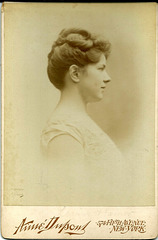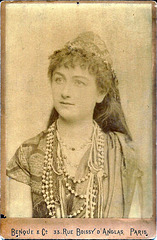
19TH CENTURY OPERA SINGERS
Louise Homer by Aime Dupont
| |
|
LOUISE HOMER
(Louise Dilworth Beatty )
(April 30, 1871 – May 6, 1947)
American Contralto
After some study in Philadelphia and boston she travelled to Europe to complete her training with Jacques Bouhy in Paris . Debut at vichy as Leonore "La Favorite" . was at Covent Garden for 2 seasons in 1899 as Ortrud , Amneris , Mamma Lucia and Maddelina . Returned to USA in 1900 and made her Metropolitan debut as Amneris , she stayed at the Met until 1919 and returned for the 1927-1930 seasons,
Felicie Kaschowska by Aime Dupont
| |
|
FELICIE KASCHOWSKA
(1872-1951)
Polish Soprano
Discovered by Tamberlik and encouraged to undertake training with Troschei in Warsaw and Gansbacher at Vienna . Debut at Warsaw as Alice "Robert le Diable" in 1888. appeared at the Met the opening night of the season as Urbain in (Hugenotten) Returned the following year adding Jemmy (Wilhelm Tell) , Sibel (Faust) , Hirtenknabe (Tannhauser) , Wellgund (Rheingold & Gotterdammerung) graduating to Senta ans Sieglinde.She sang in Vienna , Budapest and various German theatres
Mily Meyer by Chalot
| |
|
MILY MEYER
(Émilie Mily Meyer)
(1852-1927)
French Soprano
Her professional début was at the Eldorado café-concert; she then went to the Théâtre de la Renaissance and appeared as the young duchess in the premiere of Le petit duc on 25 January 1878. Creations in La Camargo (1878),[2] Petite Mademoiselle (1879) and Belle-Lurette (1880) swiftly followed
also appeared at the Théâtre des Nouveautés as Kate in the French premiere of Rip and at the Théâtre des Bouffes Parisiens as Bianca in the first run of La Béarnaise in 1885. Also at Théâtre des Variétés was La Princesse de Trébizonde, while at the Théâtre des Folies-Dramatiques she was in the French premiere of Millöcker's La Demoiselle de Belleville (Die Jungfrau von Belleville).
Among many other operettas in which she sang were Roi de Carreau (1885) and Babolin (1884) at the Théâtre des Folies-Dramatiques (November 1884); La vie mondaine (1885) at the Théâtre des Nouveautés, and at the Théâtre des Bouffes Parisiens, La Béarnaise (1885), as Benjamine in Joséphine (1886), Gamine de Paris (1887), Le Retour d'Ulysse (1889), Le mari de la reine (1889), Cendrillonnette (1890) and revivals of Les petits mousquetaires and La Princesse de Trébizonde. Back at the Renaissance, she created La gardeuse d'oies (1888) and La petite Poucette (1891); followed by La Demoiselle du Téléphone (1891) at the Nouveautés, Fleur de Vertu (1894) at the Bouffes, and L'Élève du Conservatoire (1894) at the Théâtre des Menus-Plaisirs.
Josephine De Reszke By Theatrical Programme
| |
|
JOSEPHINE DE RESZKE
(Józefina Reszke)
(June 4, 1855 – February 22, 1891)
Polish Soprano
Sister of the bass Edouard and the tenor Jean de Reszke, She began her studies with her mother and with a Mme. Nissen-Salomon, and made her debut in Paris as Ophelia in Hamlet on June 21, 1875.
Created the role of Sita in Jules Massenet's Le roi de Lahore.
Josephine appeared with her brother Jean on the occasion of his debut; the two, along with Edouard, participated in the Paris premiere of Hérodiade in 1884. At the peak of her career she married Baron Leopold Kronenberg, and retired from the stage
Marie Van Zandt by Benque
| |
|
|
as Lakme in "Lakme" by Delibes CREATOR Opera Comique Paris 14/2/1883
MARIE VAN ZANDT
(October 8, 1858 – December 31, 1919)
American Soprano
Daughter of Jennie van Zandt , She studied in Milan with Francesco Lamperti, making her debut as Zerlina in Don Giovanni in Turin in 1879. Successful appearances followed, including at Covent Garden in 1879. She was only 21 signed a contract with the Opéra-Comique in 1880, making her debut as Mignon. It was the beginning of the glory. Léo Delibes composed his opera Lakmé for her, and she created the title role for its world premiere in 1883.Marie van Zandt made her Metropolitan Opera debut as Amina in Vincenzo Bellini's La sonnambula on December 21, 1891, remaining with the company for only one season, as usual. She returned to the Opéra-Comique in 1896 and revived some of her earlier success there, including Lakmé to huge enthusiasm in 1896, and Zerlina and Mignon in 1897 .She married with a Russian Count and went into retirement, staying in France
Cecile Simonnet by Benque
| |
|
Simonnet as Selika 'Lakme"
CECILE SIMONNET
1865-???
French Soprano
Entered the Conservatoire de Paris in 1882. Debuted in Monte-Carlo in January 1885 under the direction of Pasdeloup. Debuted at the Opéra-Comique on September 10, 1885 in Lakmé (Lakmé) to replace Van Zandt. She sang Mignon (Philine), Mireille (Mireille), le Pré - aux - clercs, la Traviata (Violetta). The evening of the burning of the salle Favart on 25 may 1887, she sang Mignon (Philine). She created Mary one day; in 1886 the Signal; in 1887 Proserpine; in 1890 Dante; on June 18, 1891, the dream (Angelique).
Anna de Friedebourg by Ken
| |
|
ANNA CARLOWNA FRIEDEBOURG
25 December 1829- 11 May 1903
Russian Contralto
Wife of pianist Theodore (Fedor) Leshetitsky. She was born in St. Petersburg in the family of a doctor, she showed bright musical abilities from her childhood. The attention of Grand Duchess Elena Pavlovna attracted attention, which took her in 7-year-old7-year-old age for education in the Mikhailovsky Palace. In 1848 she graduated from the Mariinsky Institute, she studied singing. She performed in opera with Italian singers. Repeatedly played with A.G. Rubinstein. Since 1856, together with her husband, she has performed concerts in the cities of Russia and in Europe. She participated in the creation of the Russian Musical Society (1859), performed (until 1863) in his concerts. She finished her performances in 1891. From 1871 she was teaching, giving private lessons, teaching at music schools. She was buried at the Nikolsky Cemetery of the Alexander Nevsky Lavra.
A pupil of Viardot, Garcia, her method was perfect, and as for the depth of sentiment she expressed, I can only repeat what Anton Rubinstein said: “That voice was a tear.” It was the grand duchess’ wish that her gifted young protégée should become acquainted with the songs of Schubert, Schumann, Mendelssohn, and others of the German school; and it was with great zeal that pianist Theodor Leschetizsky undertook his task. They married 1856 and remained together until 1871 when they divorced
Mathilde de Carponne by Ogerau
| |
|
MATHILDE DE CARPONNE
(Mathilde Albertine Craponne)
14th May 1871 -
French Soprano (born Algeria)
Studied with Emilie Ambre-Bouichere, .Created on 24 may 1899 a spirit in “Cendrillon” by Massenet ,le Gavroche and Elise in “ Louise” by Gustave Charpentier. 1900 , Zerlina in “la Fille de Tabarin “ by Gabriel Pierné 1901 ,Lisette in “le Légataire universel “ by Georges Pfeiffer 1901, Madame Dugazon in “Madame Dugazon” by Charles Hess 1902 , Loustic in “la Troupe Jolicœur” by Arthur Coquard 1902 , Melka in “Muguette” by Edmond Missa 1903, Robin in “ Titania “ by Georges Hüe 1903. Potachin in “ Feminissima” by Gaston Lemaire 1904.She participated in the premiere, on May 30, 1900 of Hansel and Gretel (Hansel) by Engelbert Humperdinck [French version of Catulle Mendès].Roles included Catherine in “les Amoureux de Catherine” by Marechal , Bettly in “Le Chalet “ by by Adam ,Jenny in “ Le Dame blanche” by Boieldieu ,Brigitte in “ le Domino noir “ by Jolivet ,Gertrude in Le Maitre de Chappelle” by Cimarosa and Paisiello, Mignon in “Mignon” by Thomas , Vincenette, Andreloun in “ Mireille” by Gounod , Rosette in “ Manon “ by Massenet .Nicette in “ Le Pré - aux-clercs “ by Herold and Lampito in “ Phryne” by Saint-Saens
Marguerite Chapuy by Maunoury
| |
|
MARGUERITE CHAPUY
1850-????
French Soprano
She undertook lessons with Arnoldi (her first teacher having been Belloni), In 1870 she moved to Brussels, where she continued her vocal studies,
In 1872, Chapuy sang Susanna in Le nozze di Figaro, and Haydée by Auber at the Opéra Comique. She created the role of Philomène in Le roi l'a dit by Delibes on 24 May 1873. In March 1874 she sang Mignon. She was invited by Mapleson to sing in London, where her repertoire included Zerlina, Susanna, Rosina and Lucia Most notably Chapuy was the first Micaëla in Bizet's Carmen on 3 March 1875.
Chapuy sang Rosina in The Barber of Seville in July 1875 at the Drury Lane Theatre, London She sang in the premiere of Henri Maréchal's opéra-comique Les amoureux de Catherine on 8 May 1876, Chapuy sang Catherine. She then sang Baucis in the first performance of the 2-act version Gounod's of Philémon et Baucis (16 May 1876).
In 1876 she married Louis Joseph Nicolas André a major general of the French army and shortly after retired from the stage.
Christine Nilsson by Reutlinger (10)
| |
|
CHRISTINE NILSSON
(Sjöabol near Växjö, Sweden, August 20, 1843 - Stockholm, 22 November 1921). Swedish Soprano
Debut October 27, 1864, Théâtre-Lyrique. Debuted at l'Opéra de la salle Le Peletier on 09 March 1868 by creating Opehlia in HAMLET ,Sang in the premiere on 03 March 1869 Marguerite in Faust at the Palais Garnier. She sang LA LEGENDE DE SAINTE CECILE , oratorio by Benedict; ROBERT LE DIABLE (Alice). Meyerbeer
Carlotta Patti by Reutlinger (4)
| |
|
CARLOTTA MARIA PATTI
( 1840 – 27 June 1889) operatic soprano
Sister to famed soprano Adelina Patti. . Born into a musical family, Patti studied the piano in her youth before following her younger sister's inclination toward singing. As a child, Carlotta developed a handicap which caused a noticeable limp in her walk. Due to this condition she mostly avoided operatic performances and preferred to sing on the concert stage. While not able to achieve her sister's level of acclaim, Carlotta nonetheless received top billing in concerts in the United States of America, Great Britain, and Australia. She was known for her extensive vocal range, reportedly being able to reach a G sharp in altissimo.[4] She often sang songs such as Der Hölle Rache kocht in meinem Herzen that highlighted this extensive range. Carlotta Patti died of cancer in Paris on 27 June 1889.
Nina Friede by Photography of Imperial Theatres in…
| |
|
NINA FRIEDE
1859-????
Russian Mezzo
Took lessons at the St Petersburg Conservatory unde Iretskaya , In 1880 she went to Vienna to study with Mathilde Marchesi . Was engaged for a season at Teatro Nicolini im Florence . Made her debut as Pieretto ' Linda di Chamounix ".
She sang at the Liceo Barcelona and made concert appearances at Moscow and St Petersburg . She was a principal at the Marinsky 1884-1891 . She sang among others Amneris (Aida) , Pauline (Queen of Spades) , Khontchakovna (Prince Igor) and Olga (Eugen Onegin)
Marguerite Priola by Maunoury
| |
|
MARGUERITE PRIOLA
(Marguerite Marie Sophie Polliart)
(Paris, 02/10/1849-13.Marseille, 27/10/1876)
French Soprano
Daughter of Jules - César Patrick, general manager of the theatre of the Folies-Dramatiques
Debut as The Messanger of Peace "Reinzi" Wagner April 06, 1869 at the Théâtre-Lyrique. Debuted at the Opéra-Comique in 1869 in Rêve d'amour. . She created on 30 November 1872 Don César of Bazán (Maritana) by Jules Massenet. Giving a representation of Mignon in 1876 in Marseille, Her voice apparently broke and she was hissed from the stage. The impression of the hostile event she took to heart and caused her to go become physically and mentally ill, she died a few days later, at the age of 26.
Francesco Tamagno by Guilio Rossi
| |
|
FRANCESCO TAMAGNO
(28 December 1850 – 31 August 1905)
Italian Tenor
Best known as the creator of the protagonist's part in Verdi's Otello at La Scala, Milan in 1887, he also was the first Gabriele Adorno in Verdi's 1881 revision of Simon Boccanegra, a far more lyrical assignment than the "Moor of Venice". He participated, too, in the premiere of Verdi's Italian-language version of Don Carlos when it was staged at La Scala in 1884, singing the eponymous role of the Infante of Spain. Five other operas in which Tamagno created leading roles were Carlos Gomes' Maria Tudor (in 1879), Amilcare Ponchielli's Il figliuol prodigo (1880) and Marion Delorme (1885), Ruggero Leoncavallo's I Medici (1893) and Isidore de Lara's Messaline (1899).
He was lauded for his performances of such established parts as Manrico in Il trovatore, Don Alvaro in La forza del destino, the titles role in Ernani and Poliuto, Arnold in Guillaume Tell, John of Leyden in Le prophète, Raoul in Les Huguenots, Vasco in L'Africaine, Robert in Robert le diable and Eleazar in La Juive. He excelled in the newer dramatic parts of Radames in Aida, Samson in Samson et Dalila, Alim in Le roi de Lahore and John the Baptist in Hérodiade. Yet, in his younger days, before his voice grew too robust, he was able to negotiate a role as light and graceful as that of Edgardo in Lucia di Lammermoor due to his accomplished mezza-voce singing.
Euphrosyne Parepa-Rosa by Warren
| |
|
EUPHROSYNE PAREPA-ROSA
(7 May 1836 – 21 January 1874)
British Soprano
Her operatic début was at the age of 16 in Malta as Amina in La Sonnambula, followed by engagements in Naples, Genoa, Rome, Florence, Madrid, and Lisbon. She sang at the Lyceum Theatre, London, for the 1857 season (the year after the Royal Opera House in Covent Garden burnt down), and between 1859 and 1865 appeared in opera at both Covent Garden and Her Majesty's Theatre. During this time, she participated in two operatic premieres, creating the title role in Alfred Mellon's Victorine on 19 December 1859, and the role of Mabel in George Alexander Macfarren's opera Helvellyn on 5 November 1864.
She then toured the United States with cornetist Levy and violinist Carl Rosa, the latter of whom she married in New York City in 1867. Together they quickly established the Parepa-Rosa English Opera Company there, which became popular, and which introduced opera to places in America that had never staged it before. They opened at the French Theatre on Fourteenth Street, New York City in September 1869 with a performance of Bale's opera The Puritan's Daughter, with Parepa singing the title role. The subsequent tour of the eastern and midwestern states included a repertoire that ranged from The Bohemian Girl and Maritana to Weber's Der Freischütz and Oberon
In 1870, the Parepa-Rosa Opera Company returned to Britain and then appeared in Italian opera at Cairo, Egypt, followed by a return to America for another successful tour in 1871-71. In 1872, they returned to Britain. In September 1873, the company changed its name to Carl Rosa's English Opera, since Parepa was pregnant Parepa-Rosa died in childbirth in London at the age of 37 while preparing a production of an English version of Richard Wagner's Lohengrin.
Adelina Patti by Davis (7)
| |
|
ADELINA PATTI
(19 February 1843 – 27 September 1919)
Soprano
Her voice was noticed very early and she nade her first tour in America at the age of seven years and was a huge success. Studied singing in New York under the direction of Maurice Strakosch, her brother-in-law, and in 1859 she sang in New York in Lucia di Lammermoor. At Covent Garden theatre in London in 1861 where she sang la Sonnambula, her reputation was strengthened and in 1862 she was singing in Paris at the Théâtre Italien, where she soon became the star. She remained at Paris until 1870, being heard in London during the summer season. In Paris she sang the Italian Repertory, in London the french Repertory. After a long stay in America and London, Patti returned several times to Paris at the Opera (debut in 1874) and the Théâtre de la Gaîté. Then she resumed travels and successfully created, in London, in 1882, the Charles Lenepveu's Velléda. She also created Dolores of André Pollonais in Nice on February 22, 1897. She triumphed especially in a vast Italian repertoire that suited to her beautiful light soprano voice. His career lasted for fifty-six years.
Céline Anna van Ghell by Vauvray
| |
|
CELINE ANNA VAN GHELL
(1847-?)
Dutch mezzo-soprano.
Began her “French” career in Brussels in the role of Rothomago junior in Ennery’s theatre play “Rothomago”. After Brussels she continued her career at Paris where she performed the same role at The Châtelet in 1877. In 1869 she created at the Théâtre des Folies-Dramatiques the role of Méphisto in Hervé’s “Le petit Faust” in which the composer himself (who was also a deserving tenor singer) created the role of Faust. In 1869 she also created the role of Prince Raphaël in the 3-act version of Offenbach’s “La Princesse de Trébizonde” at the Théâtre des Bouffes-Parisiens. She created the role of Gabrielle at the French première of Lecocq’s “Les cent vierges” (1872) and Bobeche in Offenbach’s “La foir Saint-Laurent” (1877
Gioachino Rossini by Charlet & Jacotin
Jump to top
RSS feed- Latest items - Subscribe to the latest items added to this album
- ipernity © 2007-2025
- Help & Contact
|
Club news
|
About ipernity
|
History |
ipernity Club & Prices |
Guide of good conduct
Donate | Group guidelines | Privacy policy | Terms of use | Statutes | In memoria -
Facebook
X


















